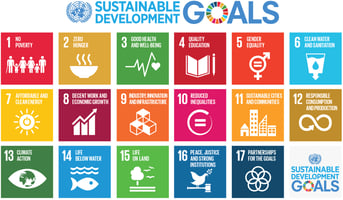A new collaboration between One Tribe and Astound Commerce will enable businesses to take immediate...
3 Steps To Making Your Events Sustainable

Download One Tribe's 'Sustainability Checklist' and learn how to make your events sustainable while gaining a deeper understanding of offsets.
In today's market where climate change concerns are at the forefront of 76% of Gen-Zer’s minds, businesses across all sectors are racing to align with the latest sustainability goals.
The events industry alone has some serious potential when it comes to attracting the new wave of eco-hungry customers. Currently producing an estimated 1.2 million metric tons of CO2 emissions annually in the UK alone (yikes) making a positive impact on the environment is an easy start for event organisers worldwide. Embracing sustainability not only demonstrates corporate responsibility but also offers numerous benefits, including increased ROI and the ability to attract and retain more attendees.
Ready To Get Started?
Our bespoke sustainability checklist is tailor-made to steer event organisers towards greener practices, helping you shrink your event's carbon footprint and offset those emissions.
Understanding The Carbon Footprint of Events
It’s no surprise the events industry is notorious for its large carbon footprint, contributing a 10% to global CO2 emissions each year. Transportation, energy usage, waste generation, and venue operations (amongst others) make up a complex network of emissions that release carbon and contribute to greater, and more pressing, climate challenges.
As climate change worsens, it's crucial for event organisers to acknowledge how their events contribute to environmental degradation and the ways in which they can take proactive steps to mitigate their impact. By adopting sustainable practices within the events industry (such as supporting regenerative practices and offsetting emissions) businesses can significantly reduce their carbon footprint and contribute to shaping a more sustainable future.
Mitigating Your Footprint Effectively
Beyond making a few eco-conscious switch-ups (plastic to paper, recycled vs. non-recycled), effectively mitigating your event footprint requires a holistic approach that encompasses three core aspects across your event planning and execution: Calculating, Offsetting, and Marketing.
1. Calculating
Calculating your event's carbon footprint is the first crucial step in understanding the environmental impact of your event. This process involves quantifying the emissions generated throughout the event lifecycle, and can span from transportation to energy consumption, to waste generation, and attendee travel.
To accurately calculate your event's carbon footprint, take a look at a few carbon calculators or consult with sustainability experts who specialise in making events Net Positive. These tools can help you gather data on various emission sources, calculate carbon equivalents, and determine the carbon footprint of your event.
By calculating your event's carbon footprint, you gain valuable insights into the specifics behind where your emissions are coming from and the quantity of emissions you are producing. What does this mean for you? This data serves as a foundation for developing well rounded sustainability strategies that can reduce emissions and mitigate the environmental impact of your events effectively. Win win!
2. Offsetting
Offsetting your event emissions involves compensating for the emissions generated by your event through investing in carbon offset projects that support renewable energy, reforestation, energy efficiency, and other sustainable initiatives.
Carbon offset projects aim to counterbalance greenhouse gas emissions by reducing an equivalent amount of emissions elsewhere or sequestering carbon from the atmosphere - Sound complicated? Don’t worry, here’s everything you need to know:
When selecting carbon offset projects, prioritise projects that have third-party certification from organisations such as Verra and Gold Standard to ensure credibility and transparency. It’s even better to support projects that align with your company's values and contribute to sustainable development goals. At One Tribe we created our very own impact pages, to help businesses track their offset projects and environmental impact in one place, helping to monitor and oversee all elements of sustainability across their event and/or business.
Offsetting your event's carbon footprint not only helps mitigate your environmental impact but also demonstrates corporate responsibility and commitment to sustainability. By doing so, you are opening up opportunities to communicate your offsetting efforts transparently to your attendees and stakeholders, showcasing your businesses dedication to environmental stewardship and empowering your audience.
3. Marketing
Obvious or not, marketing your event's sustainability initiatives is crucial in attracting more attendees to your event, as well as raising brand awareness, and amplifying the impact of your sustainability efforts. Here are a few ways you can market you impact more effectively:
- Communicate: Incorporate sustainable messaging into your event marketing materials, promotional campaigns, and communications to highlight your commitment to reducing environmental impact. Work with your partners to understand in depth your environmental impact and communicate your efforts through your social media campaigns, press releases and in-person workshops.
- Reporting: Emphasise the steps taken to calculate and mitigate your event's carbon footprint, including specific sustainability initiatives supported and carbon offset projects funded. Utilise digital platforms, social media channels, and event landing pages on your website to share sustainability stories, showcase eco-friendly practices, and encourage attendee participation in sustainable actions.
- Lead Generation: Engage event attendees in your sustainability journey by inviting feedback, promoting eco-friendly behaviours, and facilitating opportunities for active involvement in sustainability initiatives during the event. Encourage attendees to offset their own carbon footprint related to event attendance, (or do it for them) to further amplify the environmental scope of your event.
By effectively integrating calculating, offsetting, and marketing strategies into your event planning process, you can mitigate your event's environmental footprint, foster sustainable practices, and inspire positive change within the events industry.



Summary
As a whole, sustainable events are integral to achieving climate success and fostering a more environmentally responsible events industry. By acknowledging the carbon footprint of events, investing in sustainability, attracting eco-conscious attendees, and effectively mitigating environmental impact, businesses can align their event practices with sustainability goals while consuming numerous benefits, including increased ROI and enhanced brand reputation. Embracing sustainability in event planning is not only imperative but also a strategic business decision that contributes to a more sustainable future for future generations.


